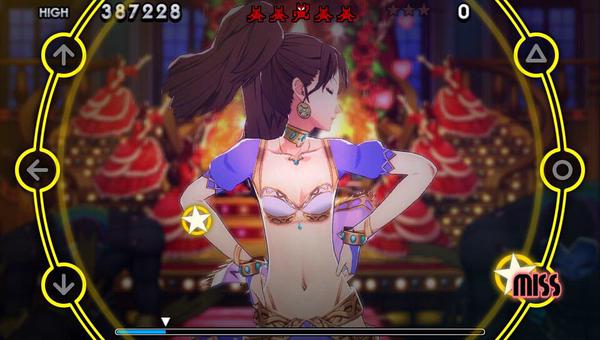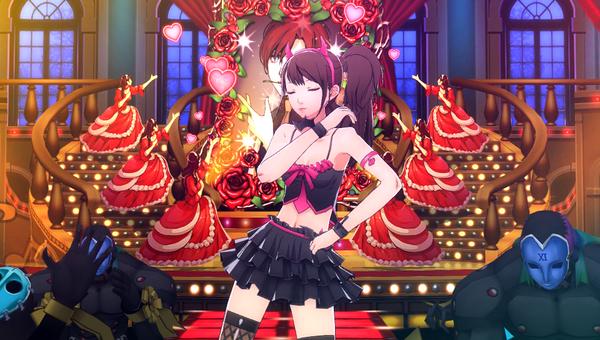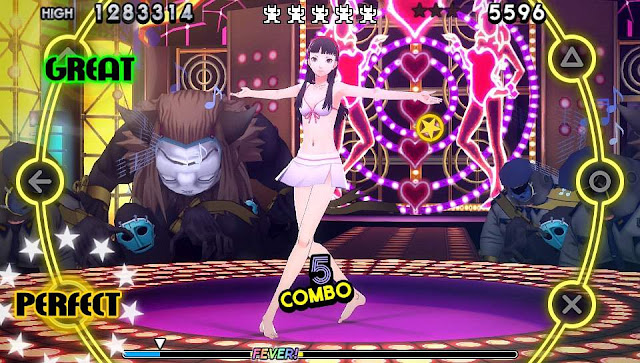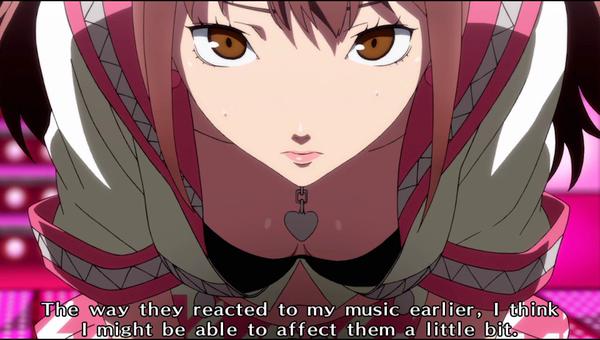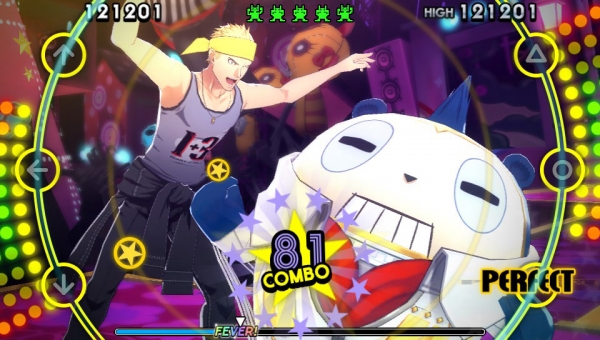You could be forgiven for thinking that Persona 4 and a rhythm game should not go well together. After all, the original game was a narrative-heavy JRPG, which meant combat, action, and lots (and lots) of dialogue. And it would only make logical sense that the foundation that original game was built on would have informed subsequent sequels and tie-ins to it. So, while the combat side of things meant that Persona 4 was always going to translate well over to a fighting game (Persona 4 Arena), the common threads that could bind a rhythm game to that franchise seemed tenuous at best, which means that might not be immediately obvious why anyone at Atlus would have thought that a dancing game based on Persona 4 would be a good idea. That was certainly my first thoughts on hearing about Dancing All Night.
Related reading: Playing Persona 4 Golden (also on PlayStation Vita) is absolutely essential before giving this game a whirl. Matt’s full review here.
But it won’t take long for that impression to fade. Sitting down to actually play Persona 4: Dancing All Night allayed my fears almost immediately, and I realised that somehow the development team has been able to bring the beloved cast of characters together and successfully throw them into something new. Now I like the direction that this game has taken Atlus’ marquee series, and I hope to see more of it.
Persona 4 and Dancing All Night might not play anything like one another, but they share thematic characteristics that mean they are identifiable as titles from the same broad franchise. The original Persona 4 ran through a veritable gauntlet of themes, as each primary character found themselves challenged to come to terms with their inner demons. This was furthered deepened by being set against an overarching nihilistic search-for-truth-style narrative. Much of this stuff is also present in Dancing All Night. The group of friends from the original Persona 4 find themselves brought together and sent on an adventure again after a mysterious website begins dragging people who see it at the wrong time into another realm, from which they don’t return. That will, of course, sound very familiar to anyone who has played Persona 4, though it comes with a downside; the assumed knowledge going into Dancing All Night is enough so that anyone who hasn’t played the original title won’t really understand what’s going on here (but you would have to have played the original to be interested in this one, right?).
In their original adventure, the group of heroes worked together to save one another from themselves. One by one, each character was pulled into a TV, which acted as a portal to another dimension. In this dimension, they discover that an uncomfortable mirror that reflects their inner selves had manifested as a monster, and they had to either come to terms with “their other self”, or be killed by it. Luckily for each character, their friends were able to go into the “TV world” too, and provide the support the suffering character needed in order to meet their inner demon head on and come out the other end the wiser and stronger for it.
This narrative delved into some pretty heavy stuff at times. One character, Kanji, found himself confronted with his homosexual inner self; something that he had been actively repressing in the real world. Another, Risette, was a pop idol who was having a great deal of trouble coming to terms with the exhibitionism that came with her career path. Beyond being an incredibly effective way to craft distinct dungeons from one another (with each dungeon having a visual aesthetic and soundtrack appropriate to the inner conflict of the character in question), the narrative structure also enabled the player to form an enormously emotional bond with the characters, and by the time the “inner self” end boss was defeated and the character was saved, we were left with an intense sympathy for each character. Fundamentally, that is why the majority of the Persona 4 cast has become so beloved and remembered in the many years since the original game landed on the PlayStation 2.
Persona 4: Dancing All Night brings that group back together, some years after the events of the original game, and tasks them with rescuing a group of Risette’s friends (also idols) that have been imprisoned within a world of perpetual music. Rather than hacking their way through hordes of monsters (called “shadows” in Persona lore), however, this time around the characters use their dancing abilities to find back the evil. It’s more metaphoric than logical (of course), but by dancing well, a character is able to break a trance that threatens to absorb each idol and turn them into one of the shadows. In some ways this is a relatively weak set up when compared to what Persona 4 itself offered, with each idol being rescued behaving like little more than the damsel in distress trope, as opposed to a fully fleshed out character that was central to the progress of the story. But underpinning that trope is a mass of other themes that help elevate the narrative into something more substantial than, well, Super Mario Bros.
The narrative promotes a deep respect for individuality and expression, for example. Giving in to fears and insecurities is what dooms a person in the world of Dancing All Night, forever bonding them to the other shadows. They become nothing more than a nameless, faceless, blank shape in a crowd. The only way the group of heroes are able to resist the draw of that collective is to deliberately transgress the group think, and put on a performance of their favourite songs to their own choreography. If they’re able to do that successfully, they’re able to liberate the shadows and save them from a permanent state of brainwash. This theme won’t necessarily mean a whole lot to western audiences, where individuality is taken for granted, but in Japan, where the game was developed and narrative set, and where people increasingly feel a tension with the conformity that the social environment thrusts on them and expects of them, it’s a theme that would resonate far more strongly.
Also key to the entire Persona 4 franchise is the recurring theme of nostalgia. The original Persona 4 offered a rich tapestry of nostalgia for the “old” Japan, where players were prevented at shopping at the modern supermarket that appears in their home town of Inaba, and were instead directed to shop and the run-down and decrepit traditional shopping street, where half the businesses have been closed down. Having seen this exact trend occurring throughout Japan personally I know the Japanese harbour a certain pang of regret that shopping malls are replacing the need for local shopping streets… though not enough to actually prevent the convenience of shopping malls from coming into every local area. There was also a respect for the local shrine and events such as the summer festival that lent additional weight to the aesthetic of nostalgia and tradition that runs through the narrative.
Persona 4: Dancing All Night is also nostalgic, though less so for the “old Japan,” and more a general commentary on the energy and vibrancy of youth. Each area the characters perform their dances in is gaudily coloured, like you might expect to see at a disco or night club, and both the dance moves on display and music are distinctly youthful in nature. As each character dances, his/ her friends cheer onwards and will even jump in to join in at various points. There might not be the same sense that the characters grow and mature as there is in Persona 4, but the celebration of youthful energy is endlessly appealing. Even the loading screen gets in on the theme, with an announcer’s voice that sounds like something from an 80’s disco radio show reminding you that you’re playing Persona 4: Dancing All Night before each track. As a child of the 80’s myself, I immediately found this gaudy over-the-top aesthetic amusing and pleasing in equal measures.
I also really enjoyed the way the game handled relationships between characters. One of the most important narrative features to the JRPG original was the bonds that formed between characters, and the way they would interact with one another as those relationships deepened. There was a very real nostalgia in there, too, for the kind of bonds that tend to fade after school life finishes, and indeed the closing scene of Persona 4 really tugs on the heart strings because, more than anything else, it makes it clear that the relationship dynamic between the group of friends is coming to a close (without giving away the plot for those who haven’t played it, but those who have will know what I mean). The relationships between characters aren’t as deep or intense in Persona 4: Dancing All Night, but the way the characters cheer one another on and perform on stage with one another carries with it a deep sense of a bond between them, easily drawing the player’s mind back to favourite events from the original game.
The game itself is stunning, managing to do just enough to repackage a very tired genre without taking the risk that players might not get along with it. As the character dances on the stage, a ring of six icons will appear around the edge of the screen; three to represent the D-pad on the left hand side of the PlayStation Vita, and three to represent three of the face buttons on the right hand side. It’s a very natural presentation, meaning it’s easy to immediately determine which button you’ll need to press when the “beat” appears on the screen and starts tracking towards one of the icons. From there it’s a simple matter of timing the button presses to the precise point where the note hits the icon, with the best scores coming from stringing together perfectly-timed button presses.
It’s also important to occasionally flick the control sticks in time with the music, in order to build up a “frenzy” meter which will, at various points through the track, call a friend up on screen to do a brief duet with the main character. And that’s about all there is to the actual gameplay. Far from being easy, however, the timing and precision required to get good scores requires quite a bit of practice, and the game’s choreography has a habit of focusing your attention on once side of the screen, even as you miss icons flying by on the other. On the harder difficulty tracks, you’re going to need to be really, really good if you’re hoping to get a good score.
Beyond the story mode – which as you can probably guess from the above is quite extensive, and, really, reminiscent of a visual novel – there’s only other gameplay option is the free dance mode, which allows you to tackle any of the game’s tracks according to your preference. My one real complaint about the game is that each track in this mode has a single character attached to it, so, if you really like the song, but are less attached to the character, then tough luck. But that aside, there is an exceptional range of songs on offer. All the music tracks are remixes of music from Persona 4 itself, and the mix of strong beats and the exceptional original music that was such a hallmark of the original game come together in a way that the track list is one of the most impressive of any rhythm title that you’ll ever come across.
It’s a gorgeous game, too. Beyond the brightly coloured and detailed backgrounds, the characters themselves are quite beautifully drawn and animated, and the choreography they dance through hits all the notes from fun, to comedic, to something slightly more emotive or elegant where required. Given that the characters and their designs are a key draw card and a reason that Persona 4 is so beloved, it is not surprising that the developers went to significant lengths to make sure the fans were looked after here, and that mission was very much successful.
Performing well in stages earns cash, which can be used (primarily) for buying little bonuses and additional costumes. That’s nothing we haven’t seen in other games before, but it’s a task that I couldn’t tear myself away from… at least until I had unlocked the costumes for Risette, anyway. See, Persona 4: Dancing All Night also gets the fan service just perfect, and let’s face it, at this stage of the overall franchise it’s the most committed fans the developers need to be appealing to, because they’re not going to be pulling in so many new players. Fan service in that context was mandatory of the developers, and they nailed it. Risette is one incredibly sexy virtual lady. She’s meant to be, of course, as the personification of Japan’s general idol culture, but the developers really ratchet it up here. Her belly dancer’s costume, especially, is a sight to behold (and then some).
Fans of the other characters will also be able to unlock a bunch of cute, charming, humorous or sexy costumes that suit their characterisation, and this goes for both the male and female characters. Which is just as well because let’s face it, regardless of which way you swing Yu is pretty darned awesome.
I’m actually a little disappointed that this isn’t being released on the PlayStation 4 as well, as a high definition version would only benefit the fan service side of things further. The PlayStation Vita is a powerful console and the characters and environments do look good while playing it, but the curves of the bodies and the subtlety of dance moves are lost somewhat on the small screen. I have no idea how well this will sell, but I hope it is enough of a success for Atlus to consider either a port to the home console, or an outright sequel.
The only other disappointment is one that would be considered minor to most people, but unfortunately the ones most likely to buy the game are the ones that will be irritated by it. Almost all the voice cast that played the various characters in previous games make a return for Dancing All Night, except for Laura Bailey, who played Risette in Persona 4 and had a scheduling conflict that excluded her from the new game. The replacement voice actor, Ashly Burch (who was incredible as Chloe in Life is Strange) does her absolute best to emulate the voice and mannerisms that Bailey brought to the role, but ultimately fails. It’s something I got over after a couple of hours in the story mode, but the introductory few scene nearly killed the character on me, which goes to show how important good voice actors are to roles in modern video games.
Those quibbles are easy to forgive, however, because Persona 4: Dancing All Night gets almost everything right. There’s a narrative that not only follows on from one of the finest stories ever written (and I’m not just talking in terms of video games) but succeeds in actually enhancing it. The soundtrack is absolutely incredible and does some amazing things in remixing music that was already peerless. The visual aesthetic is strong and the fan service is both playfully fun and the right side of being sexy without being sleazy. And, most importantly of all, the actual rhythm game housed within this love letter to the fans is so good that it has immediately become one of the best rhythm games of all time. I can’t recommend you play this before you’ve played Persona 4, but I’ve been recommending people play Persona 4 for years now, so I’m going to assume you have. Given that you have played Persona 4 already, you should therefore waste no time in getting stuck right into this.
– Matt S.
Editor-in-Chief
Find me on Twitter: @digitallydownld


